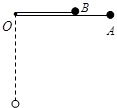问题
选择题
两质量相等的小球A和B,A球系在一根不可伸长的细绳的一端,B球系在一根原长小于细绳长度的橡皮筋一端,绳与橡皮筋的另一端都固定在O点,不计细绳和橡皮筋的质量。现将两球都拉到如图所示的位置上,让细绳和橡皮筋均水平拉直(此时橡皮筋为原长),然后无初速释放,当两球通过最低点时,橡皮筋与细绳等长,小球A和B速度大小分别为vA和vB。关于上述过程,下列说法中正确的是( )

A.小球A、B从释放的位置下落到最低点的过程中,绳和橡皮筋都对小球做了功
B.小球A、B从释放的位置下落到最低点的过程中,重力对小球A、B所做的功不相等
C.在最低点时vA<vB
D.在最低点时vA>vB
答案
答案:D
题目分析:由于A球系的是不可伸长的细线,它下落时只有重力做功,细线总是与小球的运动方向垂直,故细线不做功,A不对;根据机械能守恒定律,A球在最低点的动能等于它在A点的重力势能;对于B球,由于它的一端与橡皮筋相连,在B球下落时,橡皮筋要伸长,故橡皮筋对小球B做负功,由于原来小球A与B的高度相等,其重力势能是相等的,落到最低点时,重力对小球的功是相等的,故B不对;所以最终落到最低点时,A球的动能要大于B球的动能,由于二者的质量相等,故vA>vB,C不对,D是正确的。
